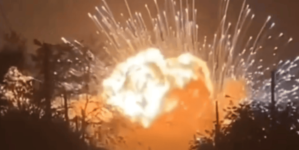-
Woman Captures Everything She Eats In A Day—On Her Wedding - 28 mins ago
-
Shoulder Season - 30 mins ago
-
Close access to Southern California forests to prevent more fires - 34 mins ago
-
My Maid of Honor Didn’t Pick Me Back and It Still Hurts - about 1 hour ago
-
The 1983 Beirut Bombings Explained - about 1 hour ago
-
Explosions Rip Through More Russian Ammunition Depots - 2 hours ago
-
F.T.C. Accuses Drug Middlemen of Inflating Insulin Prices - 2 hours ago
-
Boomers and Gen X Want to Retire Differently - 2 hours ago
-
Israeli Soldiers Throw Three Seemingly Lifeless Palestinians Off a Roof - 3 hours ago
-
Donald Trump’s IVF Dilemma – Newsweek - 3 hours ago
US Trains for Drone War in Contested South China Sea
The U.S. Air Force revealed last week that its drone units have been training for an “unmanned” war in the contested South China Sea as regional tensions continue to rise.
The “Reaper Smoke” annual competition, involving more than 30 MQ-9 “Reaper” drone squadrons, was hosted by the U.S. Air Force Special Operations Command (AFSOC) at Hurlburt Field in Florida on September 5-6, according to a press release on September 11.
An Air Force photo showed the competition featured simulated missions and strikes over Mischief Reef, a low-tide elevation of the Spratly Islands in the South China Sea. The reef is within the Philippines’ economic waters, but it has been controlled by China since 1994.
IntelWalrus, an open-source researcher on X (formerly Twitter), was the first to discover the South China Sea context in the “Reaper” competition. A monitor used by a pilot was displaying a South China Sea map that included Mischief Reef, the official photo showed.

Senior Airman Deanna Muir/U.S. Air Force

U.S. Air Force/Senior Airman Deanna Muir
This comes as the Philippines, one of Washington’s security treaty allies in Asia, has repeatedly clashed with China in the contested waters. Several countries, including the Philippines, claim the Spratly Islands, but Beijing claims over nearly the entire South China Sea.
China has been artificially increasing the size of disputed islands under its control, such as land reclamation and building ports, military outposts, and airstrips. Mischief Reef is the largest among the Chinese artificial islands, with a total area of reclamation of 1,379 acres.

Ezra Acayan/Getty Images
Responding to an inquiry from Newsweek, Lieutenant Colonel Rebecca Heyse, an AFSOC spokesperson, said the annual event “brings together MQ-9 squadrons from across the service and includes mission scenarios from different locations worldwide.”
The competition, held for the fifth time, focused on refining the skills of the MQ-9 community “across diverse mission scenarios,” enabling collaboration and networking among aircrews for shared lessons learned and best practices, the spokesperson added.
The “Reaper” is used primarily to collect intelligence, with a secondary role of striking targets. The Air Force said the remotely piloted aircraft is capable of performing strikes, coordination, and reconnaissance against “high-value, fleeting, and time-sensitive” targets.
Each aircraft is operated by two airmen—a pilot and a sensors and weapons operator. It has a flight range of 1,150 miles and a payload of 3,750 pounds, capable of delivering missiles and bombs, including up to eight AGM-114 “Hellfire” laser-guided missiles.

Airman 1st Class Victoria Nuzzi/U.S. Air Force
During the Reaper Smoke, pilots and operators participated in 30-minute tactical scenarios aimed to test their abilities and decision-making. The press release said the competition is designed to enhance “seamless communication” between the airmen behind the controls.
The U.S. Naval Institute-run USNI News reported in June that the U.S. Marine Corps has deployed its “Reaper” to the Philippines. Unlike the variant for the Air Force, the Marines “Reaper” is used to conduct intelligence, surveillance, and reconnaissance missions only.
This unarmed “Reaper” deployment, which was on a rotational basis, responded to the request from the Philippines, the report added. The deployment supported “intelligence sharing efforts” between the U.S. Indo-Pacific Command and the Philippine armed forces.
China has also been spotted deploying drones over the South China Sea. On August 2 and 7, the Chinese military sent a WZ-10 high-altitude, long-endurance drone over the waters off the coast of Vietnam, which was within the country’s exclusive economic zone.
Source link




















